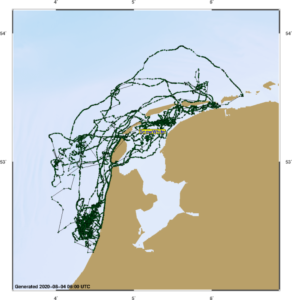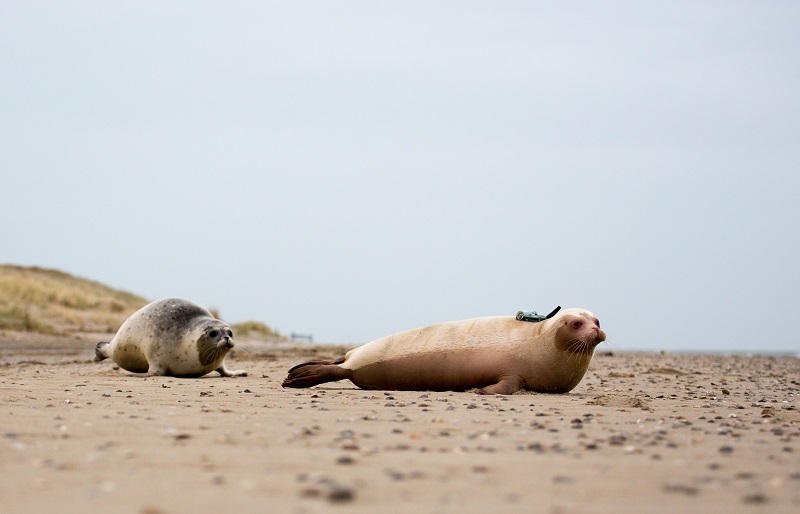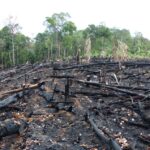Researcher Sophie Brasseur discovered this, after following Snow White, “Snow”, for months. The young seal was admitted to the Ecomare rescue facility on Texel at the end of last year. He was emaciated and suffered from a severe pulmonary infection. He was treated, and released back into the Wad, with a tracker attached to his back. ‘Ecomare wants to see how seals adjust after their release’, says Sophie Brasseur, a researcher with Wageningen Marine Research. ‘As a scientist, I am interested in learning how a young seal explores an area. Unlike many other mammals, seals are not taught by their mothers where to find food but are left to their own devices. We are not sure how exactly they do this.
In the beginning, we see him aimlessly cruising through the entire Wadden Sea
Sophie Brasseur, researcher at Wageningen Marine Research
Snow probably lost his tracker during the summer. The tracker only emits data when Snow White is within reach of a transmitter tower. ‘The transmitter has likely fallen off, as we have not received any data since June. This was expected, as seals shed during July and August. The tracker which was glued to the pelt was probably lost at sea along with the hair. We are not entirely certain, as Snow has not been seen since.’

Unique opportunity
Researchers have equipped seals with trackers before, but these were almost all feral adults or adolescents. Brasseur: ‘This was a unique opportunity to glimpse into the life of a young seal. In the wild, we would never track a young animal; catching them would cause stress in animals that are already delicate.’
Brasseur discovered that Snow developed favourite spots over time. ‘In the beginning, we see him aimlessly cruising through the entire Wadden Sea, and after some time he also starts exploring the western North Sea. After a few months, he scavenges primarily above IJmuiden, and swims to Ameland to rest.’
Albino seal
The fact that Snow survived all these months gives Ecomare hope. His limited sight, which affects Snow as an albino, seems not to impair him in his quest for food. Brasseur: ‘Seals use their whiskers for hunting.’ Despite the pulmonary infection, his lungs seem to operate well, as Snow dove to a depth of 13 metres shortly after his release. Not a record depth, says Brasseur. Seals are capable of diving as far as 600 metres below sea level. But the North Sea is not all that deep. ‘The fact that the young seal developed its diving skills and eventually dove to about 40 metres is valuable information for Ecomare because in captivity they can dive no further than two metres. So, it’s nice to know he has this ability.’
It is unlikely that Snow is negatively impacted by his albinism, for example, by being excluded. Brasseur: ‘Seals are not very social creatures. They don’t hang out together, and their sight isn’t very good. It is quite possible that he does not lie on the beach on sunny days, because he may get sunburned, but I have not yet studied this.’
Further research
Brasseur emphasises that it is difficult to draw conclusions based on a single tracked seal. She hopes this project will open doors to further research. ‘We initiated this study ourselves. Ecomare bought the tracker, and I carried out the study in my free time. We proved it works, that the tracker does not impact the seal and that it yields a lot of useful data. We know very little about the development of young seals. Where do they go? How do they develop a preference for certain areas? How does the animal know where to travel for food every year? For Ecomare, this is relevant in order to determine when and where is the best place and time to release animals, and for scientists to better understand how young seals develop. This data is interesting for me as well, since I can use it to advise the government on issues such as the effect of windmill parks and what areas should most urgently be protected.’ As is often the case, money is a limiting factor. A tracker costs 5000 euros. Brasseur and Ecomare are seeking investors to track more seals.

 Snow White with the tracker is released with Luke. Photo: Jeroen Hoekendijk
Snow White with the tracker is released with Luke. Photo: Jeroen Hoekendijk 

